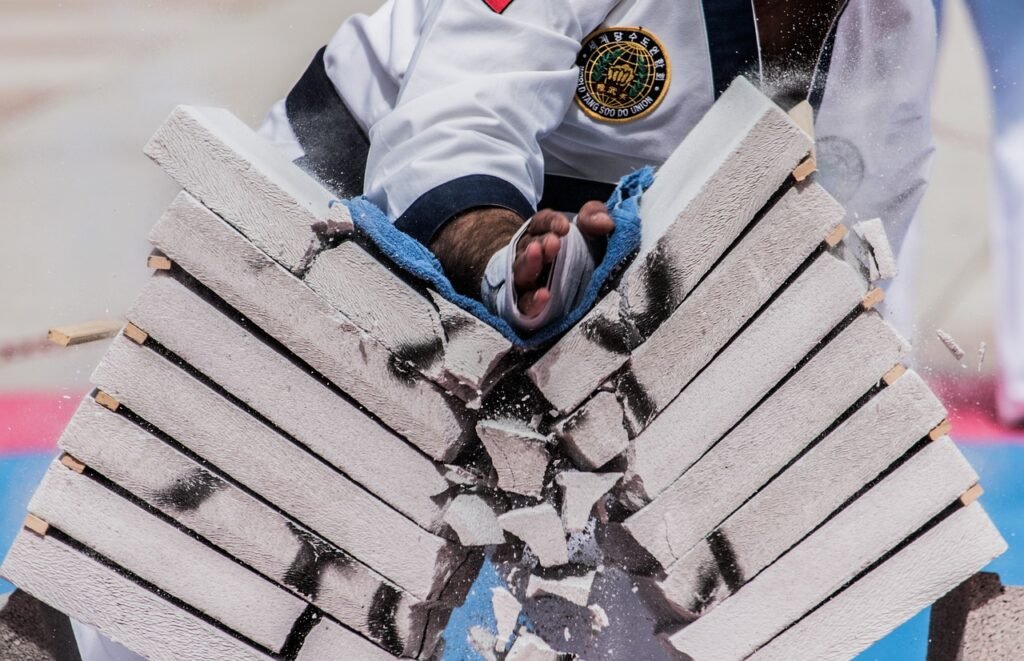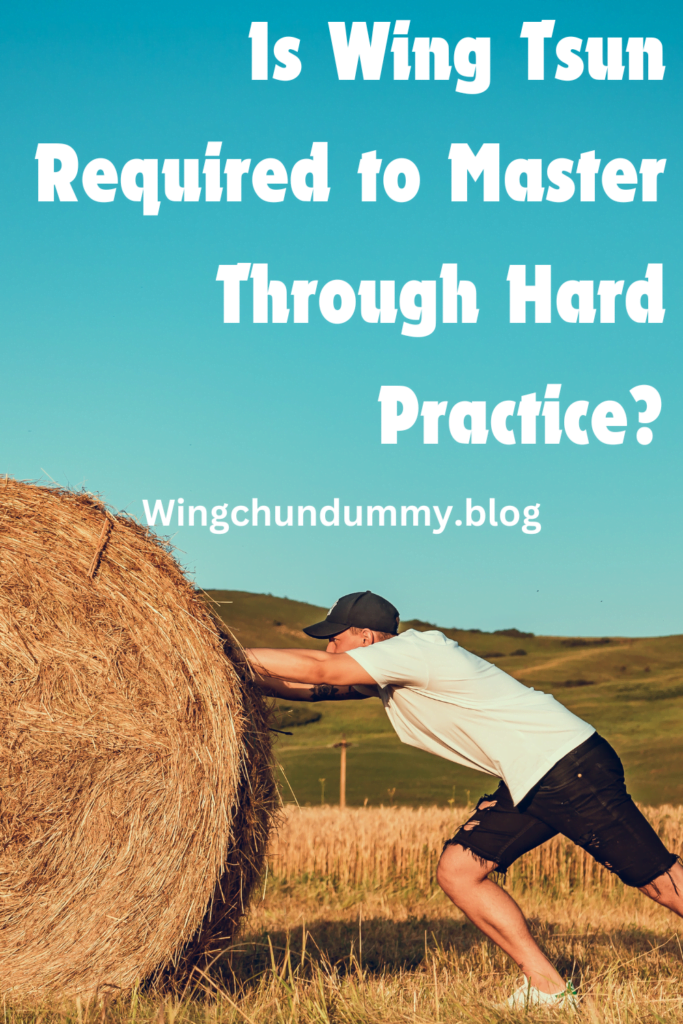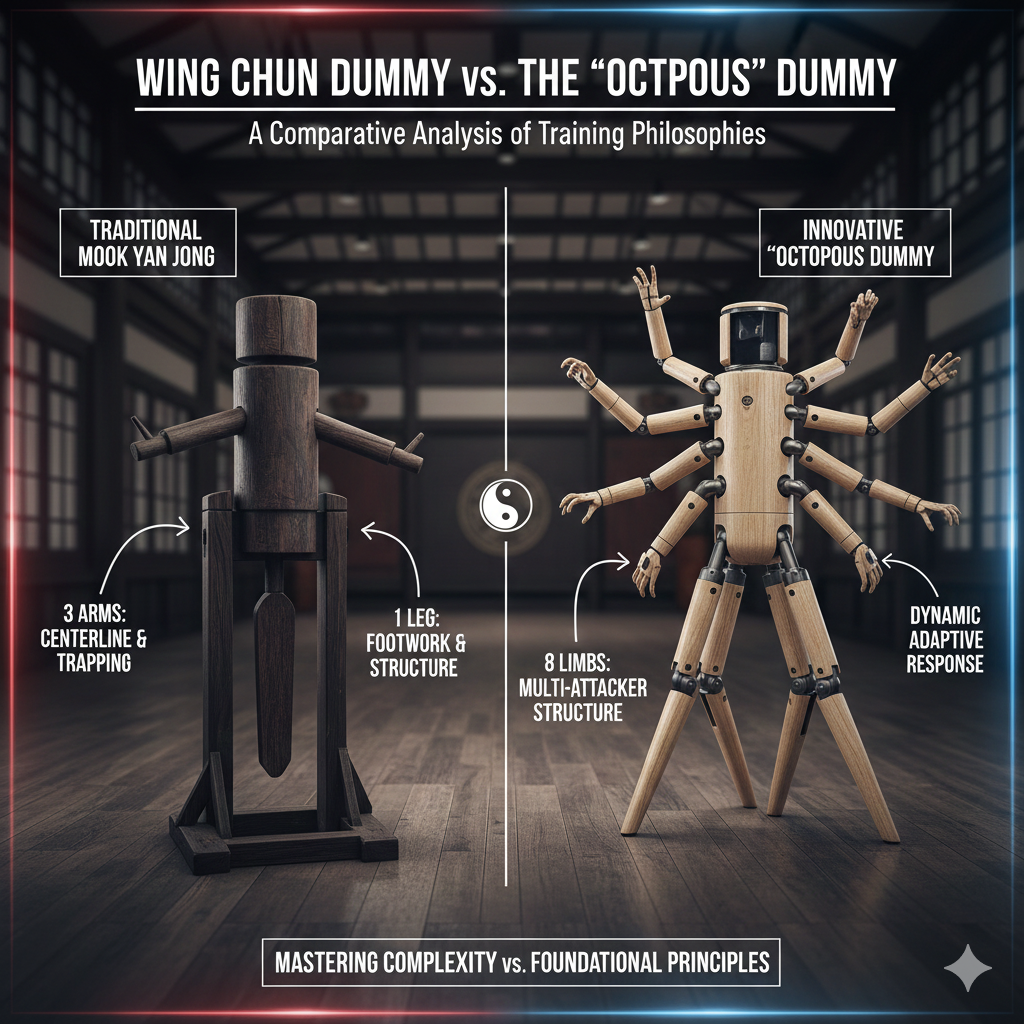Wing Tsun is a traditional Chinese martial art renowned for its emphasis on self-defense, efficiency, and directness.
Originating from the Southern Shaolin Monastery, it was developed over centuries by various martial arts masters seeking to create an effective combat system.
The art was popularized in the 20th century by Grandmaster Ip Man, whose teachings reached a global audience through his famous student, Bruce Lee.
Unlike many martial arts that focus on strength and brute force, Wing Tsun prioritizes technique and strategy.
Its primary objective is to neutralize an opponent quickly and effectively, using minimal effort.
One of the core principles of Wing Tsun is the concept of “economy of motion,” which advocates for the shortest and most efficient path to achieve a defensive or offensive goal.
This principle is evident in the art’s direct and straightforward techniques, which aim to incapacitate an attacker in the shortest time possible.
What sets Wing Tsun apart from other martial arts is its focus on close-range combat and the use of simultaneous attack and defense.
Practitioners are trained to use their opponent’s force against them, redirecting and neutralizing attacks with precision.
The art also incorporates elements of sensitivity training, where practitioners develop the ability to sense their opponent’s movements and intentions through touch, known as “Chi Sao” or “sticky hands.”
In modern times, Wing Tsun has gained significant popularity as a practical and effective self-defense system.
Its techniques are designed to be adaptable and applicable in real-world situations, making it a valuable skill set for personal safety.
Many law enforcement agencies and security professionals incorporate Wing Tsun principles into their training regimes due to its efficiency and effectiveness.

Overall, Wing Tsun remains a relevant and respected martial art, offering a unique approach to self-defense that is both practical and profound.
Its rich history, coupled with its focus on efficiency and directness, continues to attract practitioners worldwide.
Seeking to master the art for both its physical and mental benefits.
The Philosophy Behind Wing Tsun
Wing Tsun, a sophisticated martial art, is deeply rooted in principles that emphasize simplicity, economy of motion, and the strategic use of an opponent’s force.
At its core, Wing Tsun’s philosophy advocates for straightforwardness, stripping away any unnecessary or overly complex movements.
This simplicity ensures that practitioners can respond swiftly and effectively in real-world scenarios, where time and clarity of action are critical.
Central to Wing Tsun’s effectiveness is the concept of economy of motion.
This principle dictates that movements should be direct and efficient, conserving energy and maximizing impact.
By minimizing wasted effort, practitioners can maintain stamina and deliver powerful techniques with precision.
This economy of motion is not just a physical attribute but a strategic advantage, allowing Wing Tsun fighters to maintain their composure and readiness throughout an encounter.
Another fundamental aspect of Wing Tsun is the strategic use of an opponent’s force.
Rather than meeting aggression with aggression, Wing Tsun teaches practitioners to redirect and neutralize an opponent’s energy.
This redirection not only diffuses the attack but also leverages the opponent’s force against them, turning their strength into a vulnerability.
This approach embodies the art’s philosophy of using intelligence over brute force, making it accessible to individuals regardless of size or strength.
Mental discipline and strategic thinking are integral components of mastering Wing Tsun.
The training methods are designed to cultivate a calm and focused mind, enabling practitioners to make quick, rational decisions under pressure.
This mental fortitude is as crucial as physical prowess, as it allows individuals to remain composed and adaptable in dynamic situations.
The strategic mindset fostered through Wing Tsun training encourages practitioners to anticipate and counter opponents’ moves with calculated precision.
In essence, the philosophy of Wing Tsun intertwines physical techniques with mental acuity,
creating a holistic martial art that is as much about inner growth as it is about external defense.
The emphasis on simplicity, economy of motion, and strategic use of force shapes the training methods and objectives,
guiding practitioners towards mastery through disciplined practice and thoughtful application of principles.
Basic Techniques and Forms

Wing Tsun, a traditional martial art, revolves around a series of foundational techniques and forms that are essential for any practitioner.
Among the most crucial forms are Siu Nim Tau, Chum Kiu, and Biu Jee.
Each of these forms serves specific purposes and contributes significantly to the practitioner’s overall proficiency.
Siu Nim Tau, the first form in Wing Tsun, translates to “Little Idea” and focuses on fundamental movements.
This form emphasizes proper stance, structure, and balance, which are vital for effective self-defense.
Practicing Siu Nim Tau helps in developing muscle memory, ensuring that the basic techniques become second nature to the practitioner.
The form also introduces the concept of economy of motion, teaching students to use minimal effort for maximum effect.
Chum Kiu, meaning “Seeking Bridge,” is the second form and builds upon the principles learned in Siu Nim Tau.
This form introduces turning movements and coordination between upper and lower body.
Chum Kiu is essential for understanding how to generate power through body rotation and improve one’s ability to maintain balance while moving.
Consistent practice of Chum Kiu enhances the practitioner’s ability to bridge the gap between themselves and their opponent, a critical skill in Wing Tsun.
The third form, Biu Jee, or “Thrusting Fingers,” is more advanced and focuses on recovery techniques and emergency responses.
This form incorporates more complex movements, including finger strikes and elbow techniques, which are crucial for dealing with unexpected situations.
Mastery of Biu Jee ensures that practitioners can respond swiftly and effectively under pressure, maintaining control in various combat scenarios.
Consistent practice of these forms is indispensable for developing fluid movements and muscle memory.

Each form builds on the previous one, creating a comprehensive system of techniques that prepare practitioners for more advanced training.
The systematic approach of Wing Tsun ensures that every movement is purposeful, contributing to a well-rounded martial artist.
The Role of Wing Tsun Hard Practice
Mastery in Wing Tsun, like in any form of martial arts, is fundamentally rooted in hard, consistent practice.
Hard practice in Wing Tsun emphasizes a disciplined approach that includes rigorous physical conditioning, repetitive drills, and sparring sessions.
Such a structured regimen is essential for developing the reflexes, strength, and precision needed to excel in this martial art.
Physical conditioning forms the backbone of hard practice in Wing Tsun.
Flexibility, endurance, and muscle strength are cultivated through a variety of exercises designed to enhance overall physical fitness.
Conditioning also involves learning to absorb and deliver forceful blows, which is critical for both offensive and defensive maneuvers.
Repetition is another cornerstone of hard practice.
By performing techniques repeatedly, practitioners internalize the movements, making them instinctive over time.
This repetitive training ensures that techniques are executed with under pressure.
For instance, the fundamental chi sao (sticky hands) drills help practitioners develop sensitivity and responsiveness.
Enabling them to react swiftly and accurately during combat situations.
Sparring is an indispensable component of hard practice in Wing Tsun.
Engaging in controlled combat with partners allows practitioners to apply techniques in real-time scenarios.
Sparring sessions provide the opportunity to test and refine skills, improve timing,
and adapt strategies against unpredictable opponents.
This hands-on experience is vital for building confidence and competence in actual self-defense situations.
The benefits of rigorous training in Wing Tsun are manifold.
Practitioners who commit to hard practice often exhibit enhanced reflexes, greater physical strength, and superior technical precision.
These improvements not only contribute to martial prowess but also promote mental discipline and resilience.
In essence, hard practice is indispensable for anyone aspiring to master Wing Tsun.
Through dedication and perseverance, practitioners can achieve a high level of proficiency, making hard practice a cornerstone of their martial arts journey.
Balancing Hard Practice with Smart Training
In the pursuit of mastering Wing Tsun, the importance of balancing hard physical practice with smart training strategies cannot be overstated.
While there is undeniable value in rigorous physical training, an exclusive focus on intensity can often lead to burnout and injuries.
Therefore, it is crucial for practitioners to incorporate a holistic approach that includes rest periods, cross-training, and mental exercises.
Rest periods are essential to allowing the body to recover and rebuild.
Overtraining without adequate rest can result in diminished performance and increased susceptibility to injuries.
Scheduling regular rest days within a training regimen ensures that muscles and joints have the time they need to heal and strengthen.

This approach not only prevents burnout but also enhances overall performance.
Cross-training is another effective strategy in achieving balance.
Engaging in different types of physical activities, such as swimming, running, or yoga, can complement Wing Tsun training.
Cross-training helps in developing a well-rounded physical fitness, improving flexibility, coordination, and cardiovascular health, which are all beneficial for Wing Tsun practitioners.
Mental exercises play a pivotal role in smart training.
Techniques such as visualization, meditation, and breathing exercises can enhance focus, reduce stress, and improve overall mental resilience.
These practices help in maintaining a high level of mental alertness during Wing Tsun training sessions,
ultimately contributing to better performance.
Emphasizing the quality over quantity of training sessions is vital.
A knowledgeable instructor can guide practitioners in focusing on precise movements and techniques rather than sheer volume of practice.
This ensures that training is efficient and effective, targeting the development of skills crucial for Wing Tsun mastery without unnecessary strain.
In conclusion, achieving mastery in Wing Tsun requires a balanced approach that integrates hard practice with smart training strategies.
By incorporating rest periods, cross-training, mental exercises, and the guidance of a skilled instructor, practitioners can optimize their training, prevent burnout and injuries, and ultimately reach their full potential in Wing Tsun.
Real-World Applications and Sparring
Hard practice in Wing Tsun is crucial for preparing practitioners for real-world self-defense scenarios.
Unlike traditional training methods that focus solely on form and technique, rigorous practice sessions include sparring and realistic drills,
which are essential for honing practical skills.

These exercises mimic the unpredictability of real-life encounters, ensuring that practitioners are not only technically proficient but also mentally prepared to handle various situations.
Sparring, in particular, plays a vital role in this preparation.
By engaging in controlled combat with partners, practitioners can test their techniques under pressure and against resistance,
which is something that cannot be achieved through solo practice alone.
Sparring sessions reveal strengths and weaknesses, allowing individuals to refine their strategies and improve their responses.
This hands-on experience is invaluable for developing the quick decision-making abilities needed in real-world confrontations.
Realistic drills further complement sparring by simulating specific self-defense scenarios.
For instance, practitioners might practice defending against a surprise attack from behind or disarming an opponent wielding a weapon.
These drills are designed to replicate the chaos and unpredictability of actual threats, training the body and mind to react swiftly and effectively.
Techniques such as the “Chain Punch” and “Chi Sao” (sticking hands) are often utilized in these drills, emphasizing the importance of continuous movement and adaptability.
The adaptability of Wing Tsun techniques is particularly noteworthy. In real-world self-defense situations, the environment and circumstances can vary greatly.
Hence, practitioners must be able to modify their techniques on the fly.
For example, a simple deflection technique might need to be adjusted based on the opponent’s size, speed, or the presence of obstacles.
This adaptability is fostered through hard practice and realistic training, ensuring that practitioners are versatile and capable of making quick, effective decisions under pressure.
In summary, hard practice, sparring, and realistic drills are indispensable components of Wing Tsun training.
They not only enhance technical proficiency but also prepare practitioners mentally and physically for the complexities of real-world self-defense scenarios.
The ability to adapt and make quick decisions can be the difference between safety and harm, highlighting the importance of rigorous, practical training in mastering Wing Tsun.
Testimonials from Practitioners
Many Wing Tsun practitioners attest to the transformative power of rigorous training.
Their personal experiences shed light on the challenges faced and the remarkable outcomes achieved through dedication and hard practice.
These testimonials underscore the critical role of persistent effort in mastering Wing Tsun.
One such practitioner, John Lee, shares his journey:
“When I first started Wing Tsun, I struggled with coordination and balance.
The initial months were grueling, and the training intensity often left me exhausted.
However, the disciplined practice honed my reflexes and improved my physical conditioning significantly. Over time,
I noticed a marked improvement in my techniques and overall confidence.”
Similarly, Maria Sanchez, who has been training for over five years, highlights the mental fortitude required:

“Wing Tsun is not just about physical strength; it demands mental resilience.
There were moments when I doubted my abilities, especially during advanced training sessions.
But pushing through these challenges helped me develop a strong mental focus and an unwavering commitment to my practice.
The rigorous training transformed not just my Wing Tsun skills but also my approach to life’s obstacles.”
Another practitioner, David Nguyen, emphasizes the supportive community:
“The rigorous training in Wing Tsun cultivates a sense of camaraderie among practitioners.
We support and motivate each other through the tough sessions.
This sense of community helps us persevere and achieve our individual goals.
The hard practice has not only made me a better martial artist but also a more disciplined and resilient person.”
These testimonials illustrate that while Wing Tsun requires significant effort and dedication, the rewards are profound.
Practitioners consistently report enhanced skills, greater confidence,
And personal growth as direct outcomes of their rigorous training.
Their stories provide valuable insights into the transformative impact of hard practice in mastering Wing Tsun.
Conclusion: Is Hard Practice Essential?
Throughout this blog post, we have delved into various facets of mastering Wing Tsun and the role that hard practice plays in this journey.
Hard practice undeniably forms the backbone of progressing in Wing Tsun.
The repetitive drills, the physical conditioning,
And the continuous honing of techniques are fundamental to ingraining the principles and movements of this martial art into muscle memory.
Without consistent effort and perseverance,
achieving a high level of proficiency in Wing Tsun would be an arduous,
if not impossible, task.
However, it is equally important to recognize that hard practice,
while essential, is not the sole component of mastery.
Smart training strategies, which include understanding the underlying principles of techniques.
Practicing with intention, and incorporating feedback, are vital.
Mental discipline also plays a pivotal role.
The focus, patience, and resilience developed through training are critical not only for physical skill development but also for navigating the psychological challenges inherent in martial arts practice.
Moreover, an integrated approach that balances hard practice with smart and mindful training can lead to more effective and efficient progress.
This balance ensures that practitioners do not merely train harder, but also train smarter.
Avoiding burnout and injuries while maximizing the benefits of their efforts.
In conclusion, the journey of mastering Wing Tsun is a comprehensive endeavor that extends beyond mere physical exertion.
It is a blend of hard practice, strategic training, and mental fortitude.
This journey fosters not just martial prowess but also personal growth, resilience,
And a deeper understanding of oneself.
Embracing this holistic approach can lead to a fulfilling and enriching experience in the mastery of Wing Tsun.
Thanks 👍



